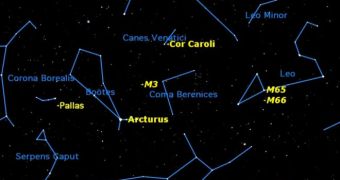Astronomers announce that skywatchers and other interested individuals will be able to spot the massive asteroid Pallas this week. This is one of the largest such space rocks ever discovered, and at one point its discoverers were wondering as to whether it's a small planet, or a member of some other class of objects. Generally, experts agree that Pallas is the second-largest asteroid out there today, though some argue that Vesta is more entitled to this position, Space reports.
Even though it's slightly smaller in diameters, at about 512 kilometers (318 miles), Vesta is more massive than Pallas, most notably due to its higher density. Its counterpart has a diameter of 524 kilometers, or 326 miles. The reason why Pallas will become visible this week is the fact that it will reach opposition to the Sun. This is possible due to the high orbital angle at which the asteroid finds itself in regard to the plane solar system's elliptic. This will render it visible in the constellation of Serpens Caput, which can be found near the Corona Borealis.
Pallas (short for Pallas Athena, the Greek goddess), was discovered on March 28, 1802, by famous astronomer Heinrich Olbers. The finding came only about a year after Giuseppe Piazzi identified Ceres, which is currently considered to be a dwarf planet. The beginning of the 19th century was a wonderful time for conducting such research. In 1804, the asteroid Juno was discovered, and, in 1807, Olbers also found the large asteroid Vesta. But the scientist is perhaps best known for his dark night sky paradox, which stated that the darkness of the sky was not in tune with a static, infinitely-large Universe.
The astronomical community almost forgot about asteroids at one point. After the heated debate that sought to classify these bodies as either planets or something else halted, the field was all but abandoned for about 40 years. It was only then that the fifth asteroid was discovered. But the discovery of the gas giant Neptune, about a year later, again overshadowed asteroids, as experts concentrated at filling in the blanks in our solar system. Over the course of a century, one could argue that the solar system transformed from a very simple place to a highly complex one.

 14 DAY TRIAL //
14 DAY TRIAL //